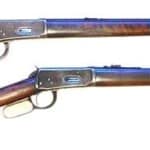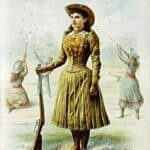
The High-Wall Rifle: An Icon of American Craftsmanship
Few rifles embody the spirit of American marksmanship and precision craftsmanship like the Winchester Model 1885 High-Wall. Designed by John Moses Browning and introduced by Winchester Repeating Arms in 1885, this falling block, single-shot rifle remains one of the strongest, most accurate, and most admired rifles of all time. With its unparalleled strength, exceptional accuracy, and historic significance, the High-Wall has cemented its place as one of the finest single-shot rifles ever built.
Origins and Design by John Browning
The High-Wall rifle was the brainchild of John Moses Browning, one of history’s most celebrated firearms designers. Browning developed the rifle in 1878, receiving a patent in 1879. His early single-shot design quickly caught the attention of Winchester Repeating Arms, which purchased the patent and introduced the rifle as the Winchester Model 1885.
Unlike the Winchester Model 1873—a lever-action repeater designed for pistol-caliber cartridges—the Model 1885 was a single-shot rifle built for powerful rifle cartridges. The rifle’s strength lay in its falling block action, a design superior to contemporary single-shots like the Sharps and Remington Rolling Block in terms of action strength and durability.
Falling Block Action: The Pinnacle of Strength
One of the defining characteristics of the Winchester 1885 High-Wall is its falling block action, widely regarded as one of the strongest single-shot actions ever produced. When the user lowers the lever, the breechblock drops vertically, exposing the chamber for easy loading. Once the lever is closed, the breechblock locks into place with an unparalleled level of rigidity, ensuring maximum strength and safety.
Advantages of the Falling Block Design:
- Unmatched Strength – Capable of handling high-pressure cartridges, including later smokeless powder rounds.
- Consistent Accuracy – The locked breechblock eliminates bolt flex, a common accuracy issue in bolt-action rifles.
- No Magazine Interference – Unlike repeating rifles, the absence of a magazine prevents mechanical inconsistencies from affecting shot placement.
- Smooth and Simple Operation – The action cycles cleanly without unnecessary moving parts.
High-Wall vs. Low-Wall Variants
The Model 1885 was produced in two primary variants:
- High-Wall – Characterized by extra-high receiver sidewalls, reinforcing the action to handle powerful rifle cartridges like the .45-70 Govt., .50-110, and .38-55.
- Low-Wall – Designed with a lower profile to accommodate low-pressure cartridges such as .22 LR, .32-20, and .25-20, making it an excellent choice for small game hunting and target shooting.
The High-Wall variant was favored by hunters and marksmen requiring a rifle that could withstand the powerful black powder rifle cartridges of the era and, later, smokeless powder loads.
Cartridge Selection and Performance
The Winchester Model 1885 High-Wall was chambered in an extensive range of cartridges, making it a truly versatile rifle. Some of the most popular chamberings included:
- .32-40 Winchester – A favorite for target shooters, offering excellent accuracy and moderate recoil.
- .38-55 Winchester – Known for its outstanding balance of power and accuracy, ideal for deer hunting.
- .40-70 Sharps Straight – A powerful black powder cartridge suitable for large game hunting.
- .45-70 Govt. – The legendary cartridge renowned for its stopping power and deep penetration.
- .50-110 Winchester – A powerhouse round designed for big-game hunting, including bison and bear.
The rifle was later adapted for modern smokeless powder cartridges, including .30-40 Krag and .30-06 Springfield, solidifying its reputation as an exceptionally strong action capable of handling high-pressure loads.
Accuracy and Precision Engineering
The High-Wall rifle earned a legendary reputation for accuracy, making it a preferred choice for competitive shooters in the late 19th and early 20th centuries. Several design features contributed to its precision:
- Rigid Action Lockup – The falling block design eliminates action flex, ensuring consistent chamber alignment.
- Heavy Barrel Options – Many High-Walls featured 30-34 inch barrels, improving bullet stability and sight radius.
- Set Triggers – Many were equipped with double-set triggers, allowing shooters to “set” the trigger for an ultra-light break.
- Superior Barrel Manufacturing – Winchester produced hand-lapped barrels, renowned for their exceptional bore uniformity.
The High-Wall dominated long-range competitions, especially in Schuetzen matches and Creedmoor long-range target shooting, where precision was paramount.
Craftsmanship and Aesthetics
The Model 1885 High-Wall wasn’t just a mechanical marvel—it was also a work of art. Early models featured high-grade walnut stocks, hand-checkered grips, and deeply blued barrels. Some rifles were further embellished with factory engravings and custom stock carvings, making them highly collectible today.
Military Use and Experimental Variants
Although never widely adopted by the military, limited numbers of Model 1885 High-Walls were tested for marksman roles, particularly in .30-40 Krag and .30-06 Springfield. Some experimental models even tested early smokeless powder loads, showcasing the action’s ability to handle higher pressures.
Modern Reproductions and Continued Legacy
Today, the legacy of the Winchester High-Wall lives on through high-quality reproductions from renowned manufacturers, including:
- Uberti – Producing faithful Italian-made reproductions, including custom engravings.
- C. Sharps Arms – Offering premium American-made models with historically accurate details.
- Browning/Winchester – Reintroduced modern High-Wall variants with improved metallurgy and precision manufacturing.
These reproductions cater to both hunters and competitive shooters, combining modern materials with the classic aesthetics and legendary accuracy of the original High-Wall.
Why the High-Wall Remains a Favorite Today
Despite its origins in the 19th century, the High-Wall remains one of the finest single-shot rifles ever made. Its enduring appeal lies in several key factors:
- Strength – Capable of handling both black powder and high-pressure modern cartridges.
- Accuracy – A rifle known for its precision, still used in competitive shooting today.
- Craftsmanship – A beautifully built firearm that represents a bygone era of superior gunmaking.
- Historical Significance – A design by John Browning that helped shape American firearms history.
- Versatility – Suitable for hunting, long-range shooting, and target competition.
Conclusion
The Winchester Model 1885 High-Wall is more than just a rifle—it’s a piece of American history. Designed by John Moses Browning, built by Winchester, and cherished by hunters, marksmen, and collectors alike, this legendary firearm embodies the very best of single-shot rifle design. Whether admired as a collector’s item or taken into the field for hunting, the High-Wall Rifle stands as a testament to an era when rifles were built to last, designed for precision, and crafted with an artistry that remains unmatched today.
Read more here:
Discussions on the High-wall Rifle can be found here.
If you know of any forums or sites that should be referenced on this listing, please let us know here.






